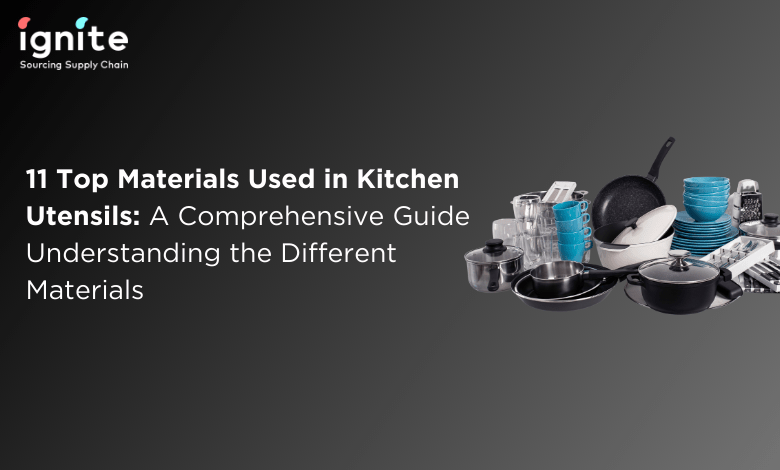Exploring the Pros and Cons of Various Material Options
Welcome to our comprehensive guide on the top materials used in kitchen utensils! Having the proper set of kitchen utensils is crucial when cooking and preparing delicious meals. Each plays a significant role in creating culinary masterpieces, from flipping pancakes to stirring sauces. However, with a multitude of materials available, choosing the correct utensils can be a daunting task.
In this blog, we will learn about kitchen utensil materials and explore the characteristics, advantages, and disadvantages of the top 11 materials commonly used in their construction. Whether you’re a seasoned chef or a beginner in the kitchen, understanding these materials will empower you to make informed decisions when selecting utensils for your cooking needs.
Introducing a Variety of Materials for Kitchen Utensils
When purchasing cookware utensils, you have many materials available in the market. Deciding which material will provide optimal results and ensure safety can often be challenging. Additionally, considering factors such as durability and price further complicates the selection process.
- Nylon
- Silicone
- Stainless steel
- Wood
- Glass
- Teflon
- Ceramic
- Aluminum
- Plastic
- Cast iron
- Copper
1. Nylon
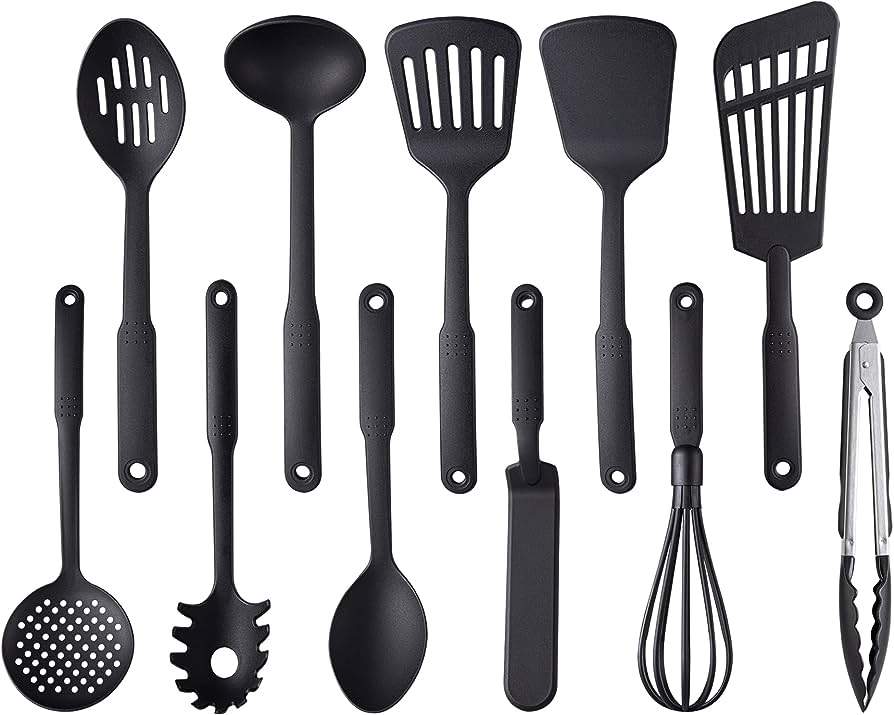
Nylon is a popular material used in the construction of kitchen utensils. It is a synthetic polymer known for its durability, heat resistance, and versatility. Nylon utensils are lightweight and have a smooth surface, making them gentle on non-stick cookware and other delicate surfaces.
| Pros | Cons |
| 1. Durable and long-lasting. | 1. May not be as sturdy as other materials. |
| 2. Heat resistant, suitable for high temperatures. | 2. Can melt or deform if exposed to excessive heat. |
| 3. Lightweight and easy to handle. | 3. Not suitable for high-heat cooking techniques. |
| 4. Non-reactive, won’t leach chemicals into food. | 4. May bend or break with rough handling. |
| 5. Gentle on non-stick and delicate cookware. | |
| 6. Easy to clean, often dishwasher-safe. | |
| 7. Affordable and widely available. |
2. Silicone
Silicone is a versatile and popular material used in kitchen utensils. It is a synthetic polymer known for its heat resistance, flexibility, and non-stick properties. Silicone utensils have gained popularity due to their many advantages and suitability for various cooking tasks.
| Pros | Cons |
| Excellent heat resistance | It may not be as durable as other materials. |
| Flexible and easy to maneuver | Can degrade or become damaged with extreme temperatures |
| Non-stick surface, gentle on cookware | Can retain odors or flavors over time |
| Easy to clean and often dishwasher-safe | May not provide the same level of precision as rigid utensils |
| Non-reactive, won’t leach chemicals into food | Can be more expensive compared to other utensil materials |
| Comes in a variety of colors and designs |
3. Stainless Steel

Steel is a combination of iron and carbon. Adding 10.5% chromium to steel results in stainless steel, while stainless steel is classified as food-grade if it contains a minimum of 16% chromium. Nickel is occasionally included in stainless steel to enhance its characteristics. Manufacturers mix stainless steel in cooking utensils with other metals like aluminum and copper to increase conductivity.
| Pros | Cons |
| Excellent durability and resistance to rust | Poor heat conductivity compared to some other materials |
| Non-reactive and does not impart flavors or odors to food | Relatively heavier compared to other utensil materials |
| Resistant to corrosion and stains | May be more expensive compared to utensils made from other materials |
| Easy to clean and maintain | Prone to scratching and may require additional care to prevent damage |
| Versatile and can be used for various cooking methods | Conducts heat unevenly in some cases |
| Compatible with induction cooktops |
4. Wood

Wood is a natural material that people have been using for centuries for making kitchen utensils. It offers a unique aesthetic appeal and brings warmth and tradition to the culinary experience. Wood utensils have hardwoods like beech, maple, cherry, or olive wood.
| Pros | Cons |
| Gentle on delicate cookware surfaces | Requires specific care and maintenance |
| Natural resistance to heat | May absorb moisture, odors, and stains |
| Non-reactive, doesn’t leach chemicals into food | Can become damaged if not properly cared for |
| Lightweight and comfortable to handle | Not suitable for dishwasher use |
| Aesthetic appeal, brings warmth and tradition | Potential for splintering or cracking over time |
| Quieter to use compared to metal utensils | Limited variety in terms of shape and design |
5. Glass

Glass is a versatile material that has gained popularity in kitchen utensils due to its unique properties and aesthetic appeal. Glass utensils have tempered or borosilicate glass, known for its strength and durability.
| Pros | Cons |
| Transparency allows for easy food monitoring | Relatively fragile and can break or shatter |
| Non-reactive, doesn’t absorb or transfer flavors | Heavier compared to other utensil materials |
| Resistant to stains and odors | Requires caution to avoid sudden temperature changes |
| Easy to clean, dishwasher-safe | Limited variety in terms of shape and design |
| Heat resistant, suitable for baking and microwaving | |
| Aesthetically appealing and allows for food presentation |
6. Teflon
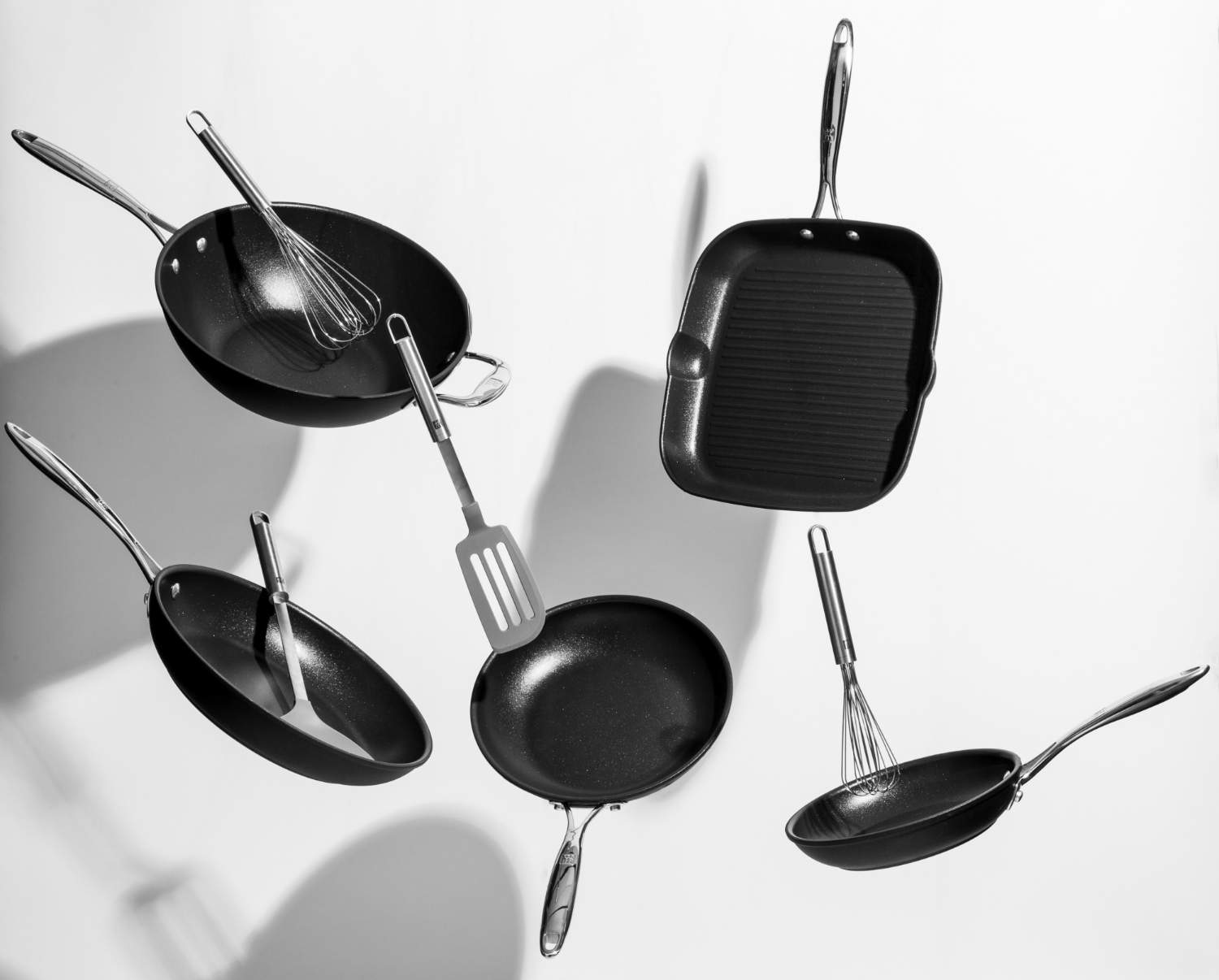
Teflon, known as polytetrafluoroethylene (PTFE), is a popular non-stick coating in kitchen utensils. It is known for its exceptional non-stick properties, which make cooking and cleaning easier. Teflon-coated utensils have become widely used due to their convenience and versatility.
| Pros | Cons |
| Excellent non-stick properties | Coating can wear off over time and require replacement |
| Easy to clean with minimal effort | Can release potentially harmful fumes if overheated |
| Requires less oil or butter for healthier cooking | Requires non-abrasive utensils to avoid scratching the surface |
| Lightweight and easy to handle | Limited temperature tolerance, not suitable for high heat cooking |
| Versatile and suitable for a wide range of cooking |
7. Ceramic
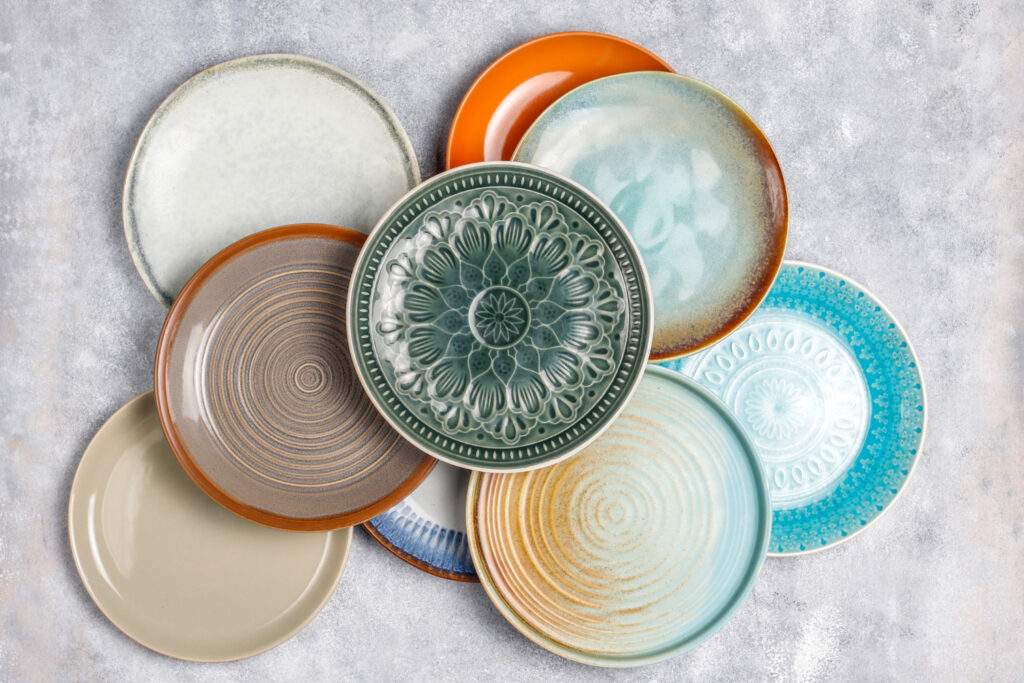
Ceramic utensils are gaining popularity in kitchens due to their aesthetic appeal and versatile functionality. Ceramic utensils contain clay fired at high temperatures, resulting in a durable and heat-resistant material well-suited for cooking and serving.
| Pros | Cons |
| Excellent heat retention and even heat distribution | Relatively heavier compared to other utensil materials |
| Non-reactive, doesn’t leach chemicals or flavors into food | More prone to chipping or breaking if dropped or subjected to sudden temperature changes |
| Non-porous, resistant to stains and odors | May require additional care to avoid extreme temperature fluctuations |
| Aesthetic appeal, available in various colors and designs | Limited variety in terms of shape and design |
| Versatile, suitable for a wide range of cooking methods |
8. Aluminum
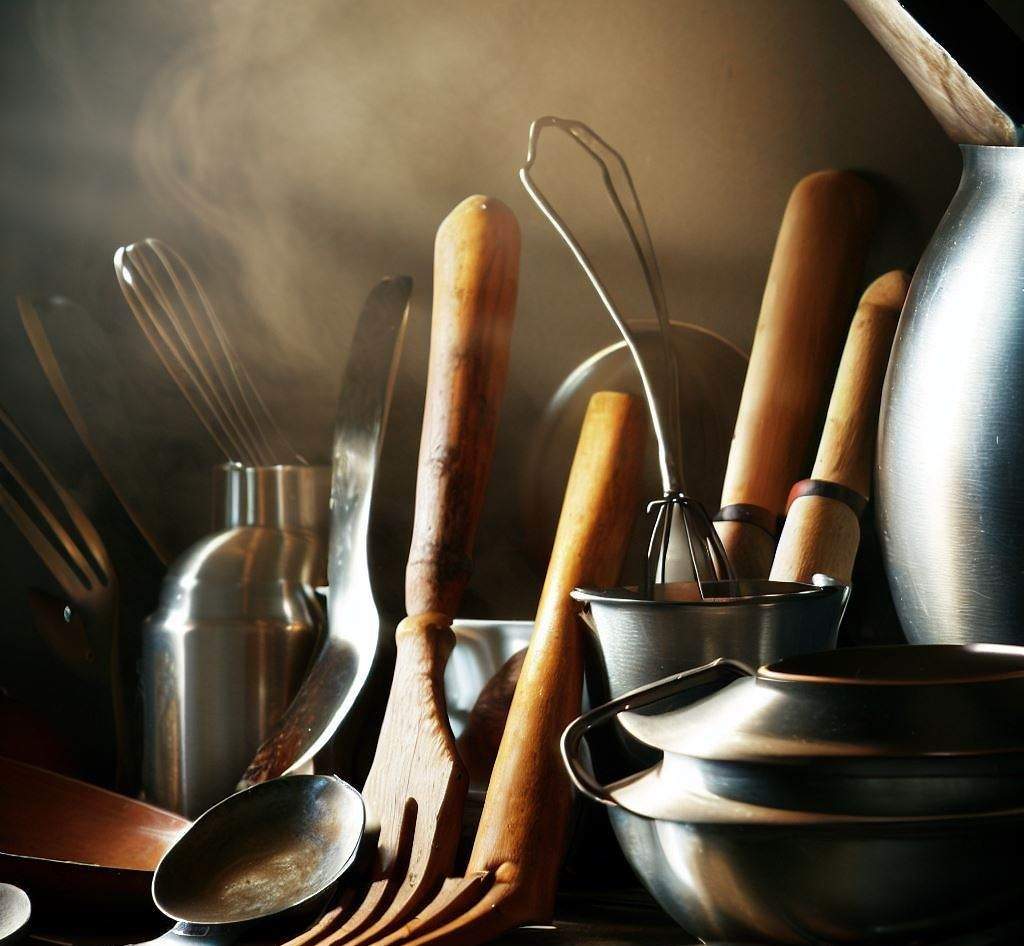
Aluminum utensils are popular in many kitchens due to their excellent heat conductivity. They heat up quickly and distribute heat evenly, allowing for efficient and even cooking. This property makes aluminum utensils ideal for tasks that require precise temperature control, such as sautéing and simmering.
| Pros | Cons |
| Excellent heat conductivity | May react with acidic or alkaline foods |
| Lightweight and easy to handle | Prone to denting and scratching |
| Affordable and widely available | Not suitable for use with metal utensils |
| Quick and even heat distribution | May warp or deform under high heat |
| Non-reactive surface when anodized | Requires special care to prevent discoloration and oxidation |
| Versatile and suitable for various cooking methods |
9. Plastic
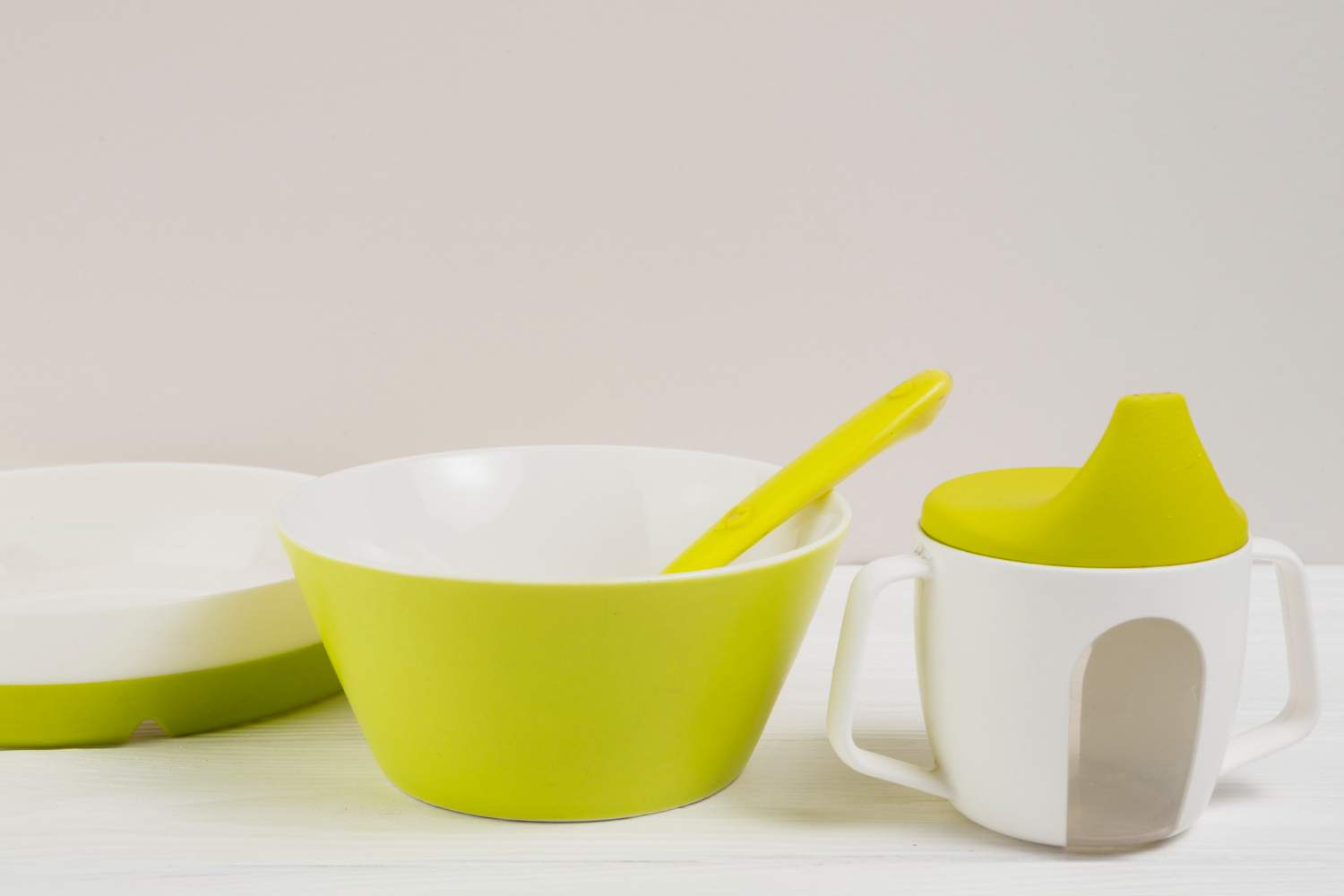
Plastic utensils are a common choice in many kitchens due to their affordability, lightweight design, and versatility. Plastic utensils have various polymers, such as polypropylene or polyethylene, which offer different properties and characteristics.
| Pros | Cons |
| Affordable and budget-friendly | Not biodegradable, contributing to environmental pollution |
| Lightweight and easy to handle | Can melt or warp when exposed to high heat |
| Durable and resistant to chipping or breaking | Some plastic utensils may leach chemicals into food |
| Versatile and suitable for various tasks | Environmental concerns with conventional plastic |
| Available in a wide range of styles and colors | Limited heat resistance, not suitable for high-temperature cooking |
10. Cast Iron
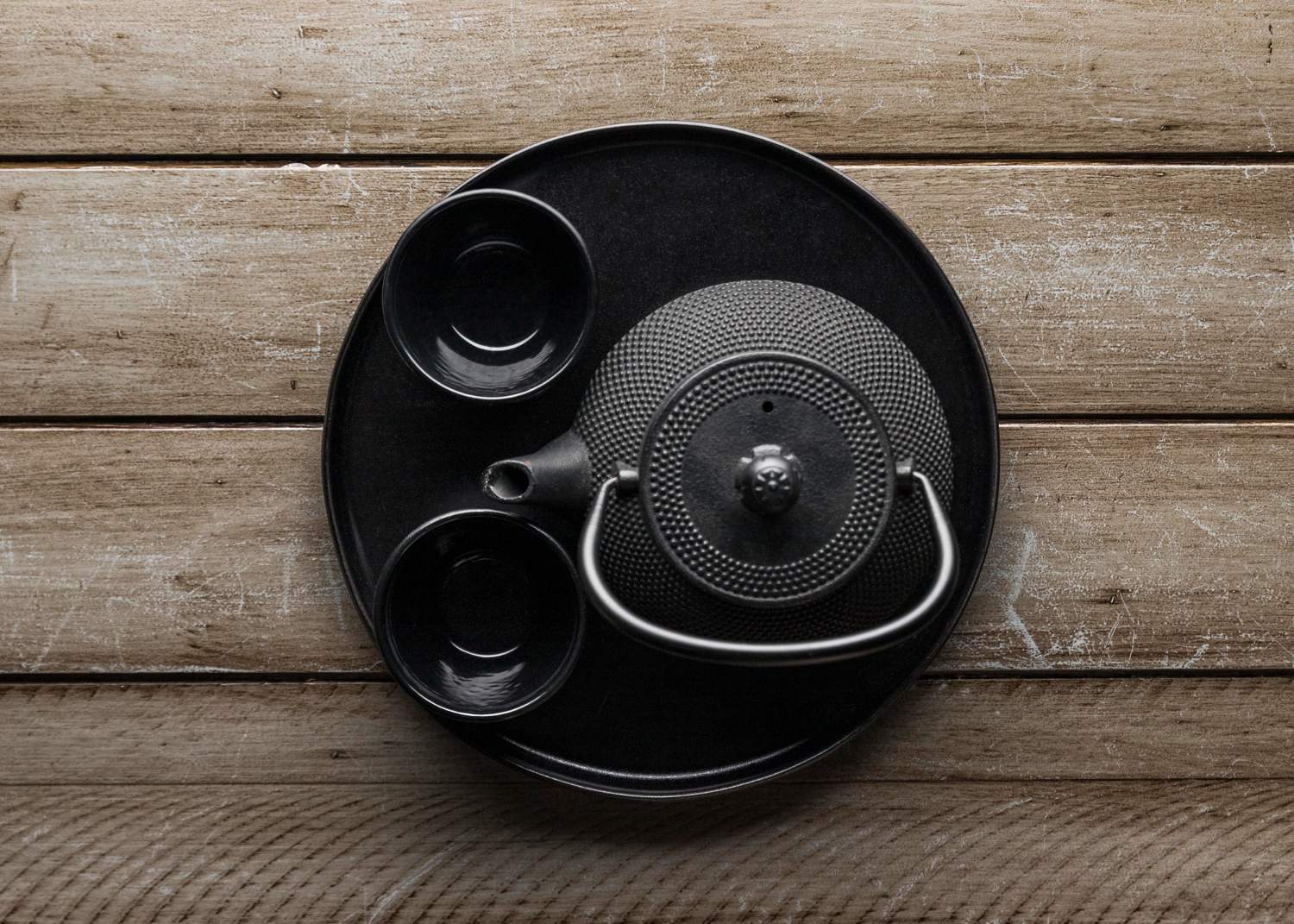
Cast iron utensils have been a popular choice for cooking and kitchenware for centuries. They make them by pouring molten iron into molds, resulting in a durable and versatile material known for its exceptional heat retention and even heat distribution.
| Pros | Cons |
| Excellent heat retention and even heat distribution | Relatively heavy and may be difficult to handle |
| Versatile, suitable for various cooking methods | Requires specific care, including seasoning and maintenance |
| Natural non-stick properties with proper seasoning | Longer heat-up time compared to other materials |
| Durable and long-lasting, can be passed down through generations | Prone to rust if not properly dried and maintained |
| Naturally non-reactive, won’t leach chemicals into food | Requires gentle cleaning without harsh detergents or scrubbing pads |
11. Copper
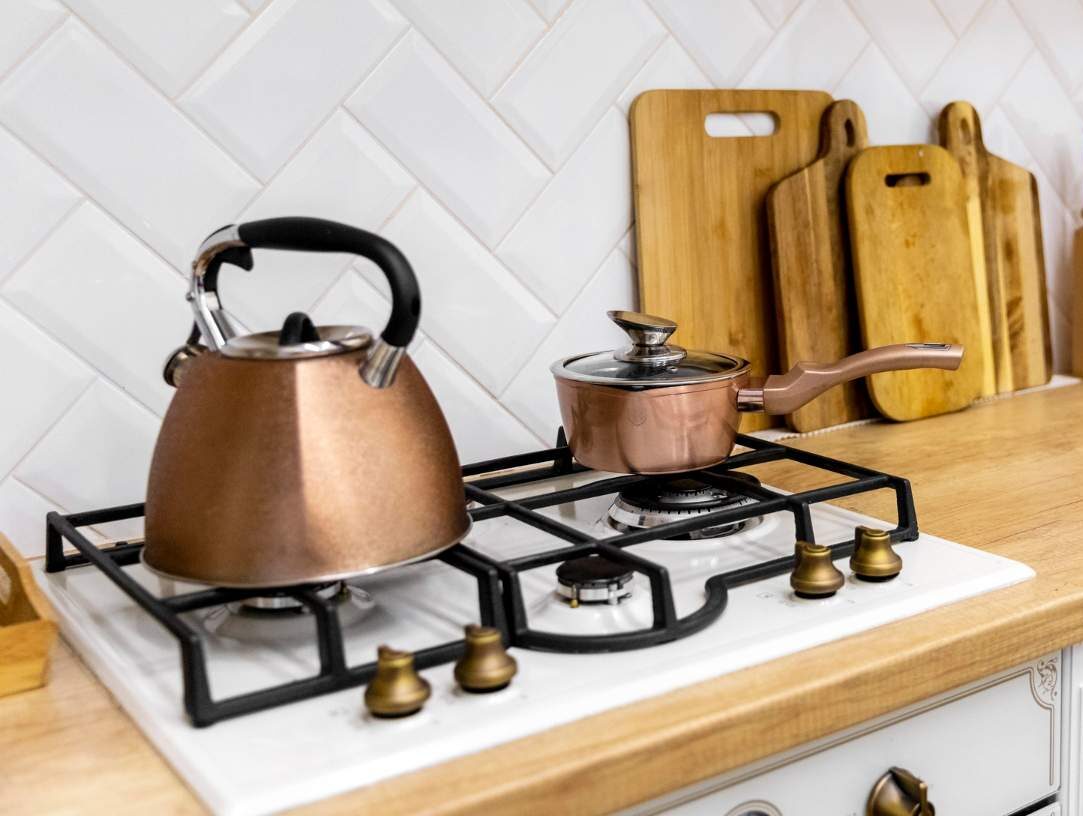
Using copper utensils in the kitchen has a long history and is favored by many professional chefs and cooking enthusiasts. Copper is valuable because of its excellent heat conductivity, precise temperature control, and aesthetic appeal.
| Pros | Cons |
| Excellent heat conductivity | Prone to tarnish and requires regular polishing |
| Provides precise temperature control | Can react with acidic or alkaline foods |
| Even heat distribution | Relatively expensive compared to other materials |
| Aesthetic appeal, adds a touch of elegance to the kitchen | Requires regular maintenance to retain its appearance |
| Versatile, suitable for various cooking methods | Not dishwasher-safe |
What Are the Common Materials Used for Handles of Cooking Utensils?
Typically, the handles of cooking utensils are composed of materials that possess the following characteristics:
- Durability
- Non-slip grip
- Oven-safe
- Easy to clean
- Water-resistant
- Free from harmful chemical leaching
- Scratch-resistant to prevent bacterial growth
- Insulating or poor heat conductor to avoid burns during cooking
Below are some materials that possess these properties:
- Steel
- Wood
- Nylon
- Plastic
- Silicone
- Bakelite
- Bamboo
Wood and plastic handles are famous for their affordability, wide availability, and possession of the most desired properties.
Which Material for Cooking Utensils is the Best for Health?
Among the various materials used to manufacture kitchen utensils and cookware, the following four are some of the safest options for heat-conducting cookware:
- Glass
- Ceramic
- Cast Iron
- Stainless Steel
Glass is highly regarded for its safety as it does not release harmful chemicals when cooking. It is non-reactive and remains unaffected by acidic or basic foods. However, glass can be fragile and prone to breakage when exposed to sudden temperature changes or force.
Pure ceramic utensils are considered completely safe for health. They do not release any chemicals into food and do not harbor harmful microorganisms. The main drawback of ceramic utensils is their relatively high cost and susceptibility to breakage when subjected to sudden temperature changes.
Uncoated cast iron is another safe option as it does not contain harmful chemicals, such as lead or cadmium since it lacks coatings. Uncoated cast iron can even release beneficial iron into the food, which can help with iron deficiency. However, proper seasoning and maintenance are necessary to prevent rusting, as rusty cast iron can pose health risks.
Cast iron is considered one of the safest materials for cooking.
Stainless steel, when anodized or coated, is generally safe for use. While some concerns exist about small amounts of nickel or cadmium from improperly used stainless steel, there is no conclusive evidence of serious health problems associated with enhanced stainless steel utensils. It is advisable to avoid stainless steel utensils containing nickel if you have a nickel allergy. Overall, stainless steel remains a reliable and commonly used material for cooking utensils.
When it comes to making spoons, whisks, stirring handles, non-stick mats, and similar utensils, the following materials are considered the safest options:
- Wood
- Nylon
- Silicone
- Bamboo
Silicone does not leach any chemicals into food and is resistant to cracking. Wood, bamboo, and Nylon also do not leach any chemicals but may be prone to cracking over time and can harbor bacteria. Wood and bamboo utensils may need replacement more frequently than silicone and Nylon for hygiene.
Which Cooking Utensils Materials to Avoid?
Here are four materials that you should use for cookware, mixing handles, storage containers, and serving equipment if you wish to steer clear of harmful chemicals in your food:
Teflon (PTFE): They used to manufacture Teflon was manufactured using PFOA, which has various health issues such as liver problems, thyroid disorders, cancer, and infertility. They banned PFOA in 2015, but a few manufacturers still use low-quality PTFE or other cheap chemicals in Teflon coatings. It is advisable to avoid Teflon cookware unless you know about the quality and safety of the brand.
Copper: While copper is an excellent heat conductor, pure copper utensils can release copper into food, and coatings like tin or stainless steel may release other harmful chemicals. Additionally, copper utensils tend to be expensive. If you are unsure how to choose the safest copper utensils, it is best to avoid them.
Aluminum: Aluminum utensils can release aluminum into food, even with premium-quality anodized or coated cookware. Coated utensils require proper care to prevent the chipping off of coatings, which can discharge toxic substances like lead or cadmium. Although sellers claim anodized aluminum is safe, the quality remains a concern. We recommend minimizing the use of aluminum cookware whenever possible.
Cheap Plastic: It is crucial to avoid plastic, except Nylon and silicone, as much as possible. Kitchen equipment from cheap plastics, such as spoons, spatulas, containers, and jars, can pose significant health risks. Investing in materials like wood, bamboo, bakelite, Nylon, silicone, and other safe alternatives is advisable, especially for mixing utensils, containers, and similar products where heat insulation is a primary requirement.
How to Choose the Right Materials for Kitchen Utensils?
Consider the following factors to make an informed decision when selecting the suitable material for your kitchen utensils and equipment:
- Cost: Take into account the price range that fits your budget.
- Durability: Assess the expected lifespan of the material to ensure long-term usage.
- Ease of Cleaning: Consider the cleaning requirements and maintenance for each material.
- Safety: Evaluate the material’s safety level, ensuring it does not release harmful chemicals or react with food.
- Oven/Microwave Compatibility: Determine if the material is safe in ovens or microwaves.
- Heat Conduction: Assess the material’s ability to conduct heat evenly for optimal cooking performance.
Cost
Everyone desires high-quality kitchen utensils and equipment at affordable prices. However, it’s important to note that inexpensive cooking utensils and equipment may compromise the quality of materials and chemicals used in their production. Therefore, it is advisable to invest in superior-quality products to prevent potential health concerns.
Safety
Ensuring the safety of your utensils is a primary concern when purchasing. Invest in higher-priced, safer utensils rather than risking potential health issues that may require extensive treatment.
Safest Materials: Utensils made from glass, cast iron, glass, wood, ceramic, silicone, and bamboo do not release any known harmful chemicals.
Requires Proper Care for Safety: Coated utensils like coated copper, Nylon, enhanced aluminum, and stainless steel may release chemicals into food if their protective coatings are scratched or chipped off. Proper care is necessary to maintain their safety.
Not Safe: Cheap plastic cooking utensils and equipment are never considered safe.
Durability
Certain materials listed above exhibit exceptional longevity, lasting for decades, while others have a shorter lifespan, measured in years or even months.
Decades Lifespan: Copper, ceramic, glass, and cast iron utensils can endure for several decades when given proper care and maintenance.
Years Lifespan: Stainless steel and aluminum cookware can last for years if they receive adequate care and attention.
Months Lifespan: Nylon and silicone utensils typically have a longer lifespan than wood and bamboo tools, lasting several months. On the other hand, cheap plastic products have the shortest lifespan among the listed materials.
Heat Conduction
Insulating Materials: When selecting handles, serving, mixing, or storage tools, opting for insulating materials is the ideal choice. Nylon, silicone, wood, bamboo, plastic, and similar materials are non-conductors of heat, making them suitable for these purposes.
Poor Conductivity: Stainless steel exhibits poor heat conductivity. Manufacturers mix it with materials that have better heat conduction properties to achieve optimal results.
Moderate Conductivity: Ceramic and cast iron are reasonable heat conductors. While they may take some time to heat up, once heated, they effectively distribute and retain heat for extended periods.
High Conductivity: Copper and aluminum are highly efficient heat conductors. However, both materials can be toxic. Therefore, they are treated or combined with other materials to ensure safe usage.
Oven/Microwave Compatibility
The above materials are categorized as follows;
Oven safe: Glass, Nylon, non-stick, silicone, cast iron, copper, ceramic, stainless steel, and aluminum are safe for the oven.
Not Safe for Oven: Wood, bamboo, and low-quality plastics are unsafe. Because they can get wrapped or burned, and plastic can melt due to high temperatures.
Microwave safe: Glass, Nylon, silicone, and ceramic are microwave safe.
Not Microwave safe: Every metal can damage a microwave. Wood and bamboo utensils can burn, while Nylon and low-end plastic can melt.
Ease of Cleaning
When it comes to cleaning kitchen utensils, different materials have varying levels of ease.
Glass: Glass utensils are generally easy to clean as they have a smooth, non-porous surface that doesn’t absorb stains or odors. People can wash by hand or in a dishwasher.
Ceramic: Ceramic utensils can be easy to clean, but consider the type of glaze used. Some ceramic utensils may have a more porous surface and require more care during cleaning to avoid staining.
Stainless Steel: Stainless steel utensils are known for their durability and ease of cleaning. They are resistant to staining and can be washed by hand or in a dishwasher. However, be mindful of using abrasive cleaners or scrubbers that can scratch the surface.
Nylon and Silicone: Nylon and silicone utensils are typically dishwasher-safe and easy to clean by hand. They have smooth surfaces that don’t retain food particles, making them convenient to maintain.
Wood and Bamboo: Wood and bamboo utensils require gentle hand washing to prevent water absorption and cracking. It’s best to avoid soaking them for prolonged periods and use mild soap and warm water for cleaning.
Plastic: Plastic utensils can vary in their ease of cleaning depending on the quality. Higher-quality plastic utensils are often dishwasher safe, while lower-quality ones may need careful hand washing to prevent damage.
Cast Iron and Copper: Cast iron and copper utensils require special care when it comes to cleaning. They are not dishwasher safe and should be cleaned by hand using mild soap and water. It’s important to avoid using abrasive cleaners or harsh scrubbers that can damage the surface.
Aluminum: Aluminum utensils can be relatively easy to clean but are prone to staining and discoloration. They are typically hand-washed using mild detergent and a soft cloth or sponge.
Which type of stainless steel is the most suitable for cooking?
In the current market, there are numerous variations of stainless steel available. Steel incorporates carbon into iron, and for stainless properties, they add 10.5% chromium. For stainless steel to be considered food grade, it must contain a minimum of 16% chromium.
The grades commonly used for creating utensils and drinkware are 201, 304, and 316 stainless steel. They increase the corrosion resistance by higher amounts of chromium and nickel but also contribute to higher product costs.
| Stainless Steel Grade | 201 Stainless Steel | 304 Stainless Steel | 316 Stainless Steel |
| Chromium | 16% – 18% | 18% | 16% |
| Nickel | 3.5% – 5.5% | 8% | 10% |
| Rust Resistance | Least | Medium | Can even be used to contain salty ocean water |
| Brittle | More | Less | Less |
| Cookware Safe | Mostly | Yes | Yes |
| Drinkware Safe | No | Yes | Yes |
| Price | Lowest | Medium | Highest |
Nylon Vs Silicone
Nylon and silicone are two commonly used materials that have gained popularity for cooking utensils. It is a common query among individuals as to which material is superior.
| Property | Nylon | Silicone |
| Heat Resistance | 400° F (204.4° C) | 482° F (250° C) |
| Crack Resistance | Crack easily and harbor microorganisms | Do not crack easily but can harbor microorganisms when cracked |
| Non-stick | Yes | Yes |
| Leach Harmful Chemicals | DDM etc. | None |
| Dishwasher Safe | Yes | Yes |
| Lifespan | Less than Silicone | More than Nylon |
| Price | Less | More |
Over To You
Selecting the proper materials for your kitchen utensils is essential for ensuring safety, durability, and optimal performance in your cooking endeavors.
IgniteSupplyChain is here to assist you if you need a reliable source to fulfill your kitchen utensil sourcing needs. With our extensive network and expertise in the supply chain industry, we can connect you with high-quality and suitable products that meet your specific requirements. Whether you’re a home cook, a professional chef, or a business owner in the culinary industry, IgniteSupplyChain can provide you with the solutions you need.
For custom products manufacturing related queries please visit EverLighten.com
FAQs
The best utensils for cooking are stainless steel, silicone, or heat-resistant Nylon. These materials offer durability, heat resistance, non-stick properties, and ease of cleaning, making them ideal for various cooking tasks. Stainless steel is considered the best metal quality for utensils. It offers excellent durability and corrosion resistance and is safe for cooking as it does not react with food. Stainless steel is generally better for cooking utensils than wood due to its durability, ease of cleaning, and non-reactive nature. Grade 304 stainless steel is the best for kitchen utensils due to its excellent corrosion resistance and durability. You can find many high-quality stainless steel utensils, including All-Clad, Cuisinart, and Calphalon. Non-stick coatings, like Teflon, are generally safe for health when used with care and not overheated. Avoid using pans with damaged non-stick coatings or those made with materials known to leach harmful chemicals, such as Teflon (PTFE), copper, or low-quality plastics. Stainless steel is prone to scratching and staining. It may not have the best heat conductivity compared to other materials.Which utensils are best for cooking?
Which metal quality is best for utensils?
Is stainless steel or wood better for cooking utensils?
Which grade of stainless steel is best for the kitchen?
Which brand is best for stainless steel utensils?
Is non-stick good for health?
What type of pan to avoid?
What are the disadvantages of stainless?

